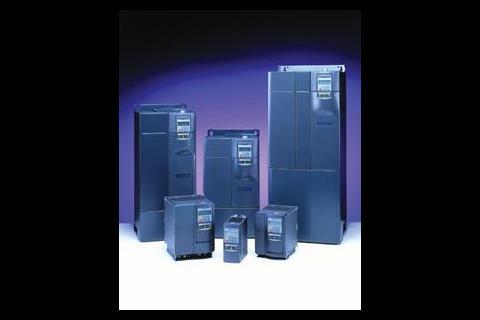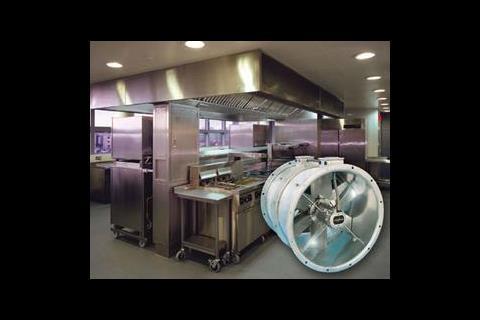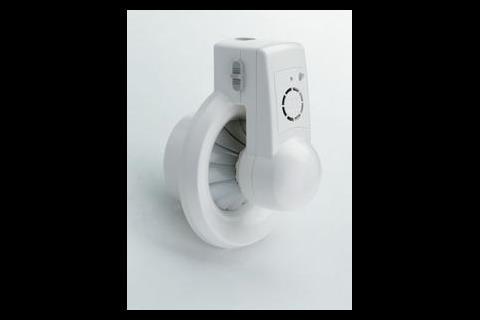A breath of fresh air hits the product focus as we take an overview of the latest developments and legislation affecting ventilation, fans and filters
Cutting harmonics in fan drives
Siemens Technologies' SED2 variable speed drives have been optimised for fan and pump applications in buildings rather than general-purpose use in industry. The new ERG5/4-1 planning guidelines for harmonic voltage distortion means the generation of power system harmonics in building services is more important than ever.
To aid the planning and control of harmonics, Siemens has produced the HarmonEE software package. This programme is free of charge and makes it straightforward for users to assess the harmonic performance of an installation in a building that incorporates multiple SED2 drives.
More information - 170
Smoke fans
Vent-Axia has introduced a range of smoke fans designed and certified to EN12101-3 for ventilating occupied spaces in the event of a fire.
The range offers a combination of fans that are temperature resistant to either 200°C or 400°C, providing emergency smoke extraction for up to two hours. The In-line adjustable pitch cased axial fan (THGT) is suitable for car parks, public buildings and shopping malls. Also for exterior-rated applications, there are the belt-driven centrifugal fan cabinets. The Centrifugal Fans (ILHT) are suitable for applications including commercial kitchen extract ventilation systems. The Vertical and Horizontal Discharge Roof mounted centrifugal fans provide the solution for smoke extract through the roof in commercial kitchens and general industrial ventilation.
More information - 171
Keeping ventilation under control
The new Approved Documents for Part F of the Building Regulations require that ventilation is effectively controlled to maintain indoor air quality and avoid waste of energy. This raises the need for precise control of ventilation systems in dwellings, particularly to reduce the risk of condensation.
West Energy Saving Technologies has developed two types of usage controls to tackle this. The Cookermiser range is for use in kitchens and senses the flow of electricity to the cooker or hob, which automatically activates the fan on demand. The Showermiser range is for use in bathrooms and works by sensing the temperature of the hot water pipe to the shower, which automatically activates the fan on demand.
Both types of sensors are simple to commission and incorporate encapsulated passive sensors that will not degrade over time, removing the need for recalibration and maintenance.
More information - 172
High pressure fans
Fläkt Woods has launched the Maxfan, designed to produce the higher pressures needed for commercial kitchen canopy applications. Managing and balancing airflow is a complex issue, and commercial kitchens require the movement of large volumes of air through ductwork and equipment placement in very restricted spaces. The Maxfan is a single phased axial fan with a speed controller optimised for pressure and suited to help overcome higher system resistances as specified by DW/172 regulations. The Maxfan develops 2.7 times the pressure of Fläkt Woods' JM fan range.
More information - 173
Smoke fans
Titon has launched the PAX 200 Series extract fan with a removable fan body, so it can be easily kept clean and is suitable for use in bathrooms. The fan has a sound level of only 30 dB(A) at 3 m, can be either ceiling or wall-mounted and has a power consumption of 4 W. Options and accessories, include external speed control, humidistat or electronic timer and all fans come with a three-year guarantee.
More information - 174
Toshiba gives you wings
New fan blade technology plays a significant part in the low-noise offer of the new Toshiba Mini-MMS VRF system. Combining Toshiba's DC twin-rotary compressor technology with inverter-controlled DC fan motor technology and a newly developed ‘bat wing' styled fan blade results in a much lower noise level from the system's outdoor unit. This ranges from just 49dB(A) in cooling for the 3 kW unit to only 51 dB(A) for the 4.5 kW unit. The bat wing design has been shown to reduce wind resistance, with wing tips manufactured to cut resistance even further.
More information - 175
Silver screen
Air4Life Nano Tech is a new air purifying system created by Carrier and used in its latest range of residential and small commercial application split system air conditioners - XPower Silentech. It consists of a Nano photo-copper filter and Nano silver ginseng filter - nano refers to the reduced filter hole size that increases filtering capacity and improves filter performance.
Nano photo-copper filtration is more efficient than traditional photo-catalytic filters because it does not require any light source to activate its equivalent photo-catalytic properties. It is anti-bacterial (up to 99.9%), deodorising and destroys volatile organic compounds. It also prevents mould formation and absorbs and decomposes smoke. The silver ginseng filter is an important part of this dual air cleaning action and its effectiveness is enhanced by embedding it into silica.
More information - 176
Changes to ventilation system specification
The changes to Part F: Means of Ventilation of the Building Regulations bring a new performance approach to air flow within dwellings, integrating mechanical and passive ventilation systems to provide a whole-house performance. Greenwood Airvac outlines the considerations for system specification.
- Dwelling design: The nature of the new performance approach requires a higher focus on design for ventilation system planning. Floor area, number of bedrooms and occupants are key criteria required for calculating whole building performance rates. New requirements, such as cross ventilation, also need to be taken into consideration, especially in single facade dwellings.
- Ventilation methodologies: There are now four detailed methods referenced in the document, each with their own specific requirements.
- Calculations: To comply with ADF, the tables in the approved document should be used to calculate building ventilation rates under each specific system. The integration of mechanical and passive ventilation solutions also brings a crucial need to focus on a ‘design’ approach to the new regulations.
- Application: The scope and complexity of ADF 2006 and the new methodologies drives away a standardised approach to ventilation system specification. The rates required may not be achievable in all types of dwellings.
- Building supply chain: The impact of changes and move towards a more integrated approach mean that material suppliers will need to understand their input into the system and have an increased focus on design.
- Building Regulations Part L: Part of the build cannot be viewed in isolation. Standard Assessment Procedure now deals differently with ventilation and energy performance must be considered in selecting a ventilation method.
For more information, please log on to www.partf.com
Source
Building Sustainable Design


























No comments yet